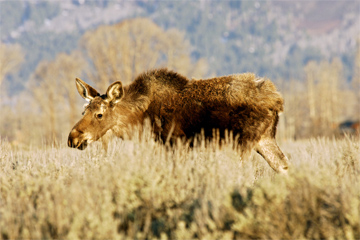Fear and conservation
WCS
December 10, 2008
How does fear shape the behavior and conservation of deer, moose and antelope, not to mention carnivores such as wolves, bears, and even tigers? What is the natural state of wildlife, and how do animals know or learn which species to ignore or fear? Should we reintroduce predators to former habitats, even though the prey animals may be unprepared for their return?
Dr. Joel Berger, Senior Conservationist of the Wildlife Conservation Society, attempts to answer these questions and more through conservation work—both his own and the work of others—around the world in his new book: The Better to Eat You With: Fear in the Animal World (University of Chicago Press, $29).
Using his extensive field experience as case studies to examine the role of fear in animal behavior, Berger asks questions and seeks the challenging answers that have implications for local and global conservation. Can naïve animals—such as the elk and moose in the Yellowstone region—relearn the importance of avoiding reintroduced predators such as wolves? Is fear passed from one animal generation to another by culture? Can an understanding of current animal behavior help inform the mysteries of why animals go extinct and how to save other species?
 Julie Larsen Maher © WCS |
“Behavioral studies on how predators and prey interact with one another are critical for understanding what constitutes healthy ecosystems,” said Berger, who is also a professor with the University of Montana. “What we’ve found is that our assumptions do not always reflect reality, and that predator avoidance in many instances is culturally acquired with many animals.”
Berger’s interest in predator-prey relationships is the result of field studies on animal species around the world, from Greenland and Siberia to Africa and Central Asia. For instance, Berger discovered that fear of predators in moose is passed from mother to young. When encountering wolves that were reintroduced to Yellowstone in the 1990s, moose were oddly indifferent to the canine predators and initially suffered heavy calf losses. In one generation, moose mothers learned to recognize the presence of wolves and to avoid them.
Other studies have hinted at inherited forms of fear. Berger broadcast the sounds of lions to bison in northern Canada, which displayed behaviors of strong apprehension. Do bison retain vestigial fears to a predator that existed in North America during the Pleistocene Epoch, more than 10,000 years ago?
Berger has also focused his predator-prey studies on bears, musk oxen, lions, and rhinos. He used these to inform ecological conservation initiatives. Todd Wilkinson, author of Science Under Siege writes: “The Better to Eat You With builds upon the canon of important natural history literature that includes the writings of Leopold, the Muries, the Craigheads, George Schaller, E. O. Wilson, and Jacques Cousteau.”
Berger has written five books on conservation and more than 100 scientific articles.
Berger also spearheaded WCS’ biological surveys on the migration patterns of pronghorn antelope in Wyoming and other neighboring states in the 1990s. His long-standing work on “Path of the Pronghorn” inspired Wyoming Governor Dave Freudenthal to encourage the Western Governors’ Association to adopt a resolution in 2007 recognizing the importance of wildlife corridors. Berger’s work also prompted the U.S. Forest Service decision to create the nation’s first designated wildlife migration corridor to protect the 150-mile round-trip movements of pronghorn through the Greater Yellowstone Ecosystem.
This is a news release from WCS













